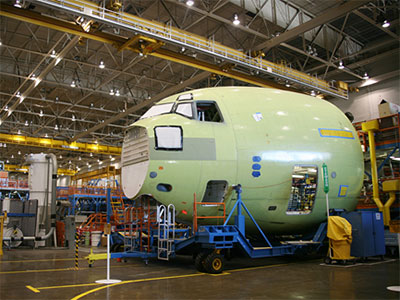

The Fragile State of the Aerospace Supply Chain
The aerospace supply chain has been struggling to recover since the pandemic. The industry has been plagued with shortages, labor issues, and supply chain issues. According to McKinsey, demand was back to 97% of pre-pandemic levels as of December 2023. Backlogs were robust and expected to grow at 5-10% per year prior to the Boeing issues. There is around 15,700 aircraft on order which would take 13 years to address at 2023 production rates, according to McKinsey. Thus, the focus was high on ramp up plans and building inventory in the supply chain.
According to Deloitte, the aerospace & defense (A&D) industry is facing unique challenges created by geopolitical conflicts, sustainability regulation and expectations, and shifting demand. Deloitte mentioned several intriguing trends related to sustainability including advanced aircraft design, the use of sustainable fuels, advanced propulsion technology, and others.
TRIGO research lines up with client and contact feedback in saying that 33% of late deliveries are the responsibility of the end customer. For example, changes in schedules, engineering changes, configuration issues, and a host of other challenges were identified. Finally, a Reuters press release quoted several issues including parts and shortage delays that could take two years to resolve, specific lead times extended 2-5 times longer than pre-pandemic, and price inflation of 20-30% on some parts.
The Boeing Issues
Just as the supply chain started to level out from the pandemic, Boeing started experiencing a wave of quality issues which sent a ripple effect through the supply chain. Although never acceptable, quality issues in aerospace can be fatal. Plagued with these issues, Boeing’s deliveries in the first quarter were the lowest since mid-2021. In fact, Airbus beating Boeing thus far in 2024.
The FAA has capped narrowbody output at a 38-jet monthly pace until Boeing resolves their quality issues. However, Boeing’s production was under this level in Q1 as they focused attention to resolving issues. Unfortunately, customers need a far more aggressive ramp up plan, and there
are limited options. In essence, Airbus and Boeing are the two giants, and both have been plagued with supply chain issues. Airbus has been slowed down with Pratt & Whitney engine inspection issues; however, they have an opportunity to gain momentum with Boeing’s obvious struggles.
Boeing Impacts on the Supply Chain
Boeing’s issues will directly impact the supply chain. Because of the aggressive ramp up plans, the supply chain has been under pressure to build inventory and ramp up to support Boeing. There is concern that Boeing will put a hold on the supply chain, leaving suppliers swimming in inventory and with supplier commitments and scaled up teams. There is likely to be a gap before can ramp up beyond 38 aircraft.
As soon as the FAA clears Boeing, the supply chain will be under rapid pressure to go from 0 to 100 in a day. Boeing hopes to get to 57 aircraft a month by Q3 2025. On the other hand, because suppliers have struggled with shortages, near-term, there are advantages in slowing down production, focusing on bringing in pacer items and clearing these pacing items before bringing in more trapped inventory. However, the timing of the critical path will be pivotal. Listen to my interview on Bloomberg on the implications of the Boeing issues.
How to Navigate
The first order of business is to ensure quality systems are intact. Going back to the basics has been a common theme across every industry. Of course, basics alone will not suffice, but you cannot build a house on a faulty foundation. Start by focusing on process disciplines, good manufacturing practices, focusing on talent and skills development, a positive and proactive customer experience, and the solid use of your ERP system and advanced technologies.
We have noticed a degradation of these basics and are passionately recommending that executives focus on execution. Don’t just take what your people say and run with it. Don’t assume common sense will prevail, don’t skip a week in monitoring progress, and don’t be afraid to stop high-paid executives from running straight into a freight train. The bottom line: don’t assume what you would have assumed a few years ago.
Beyond the basics, assess your supply chain. Learn more about our supply chain assessment and take our complimentary assessment quiz. Perform a readiness assessment. Don’t just go through the motions; dig into whether your supply chain will support your growth, profitability, and innovation objectives. Utilize your data, analyze your supply chain health with predictive analytics, and leverage advanced technologies to level up your performance.
Upgrade your processes with proactive, strategic processes such as SIOP (Sales Inventory Operations Planning) to align demand with supply and provide the visibility and insights to proactively navigate these rough waters. Cross-functional and cross-organizational collaboration with customers and suppliers through a SIOP process and collaborative programs will upgrade your performance. To learn more about these strategies, download our complimentary book, SIOP: Creating Predictable Revenue and EBITDA Growth.
Even these strategies will not be enough. Innovation must be a strategic imperative. You must focus on being 10 steps ahead of your competition, trialing new materials, investing and prioritizing R&D, and emphasizing new product development. Consider 3D printing, additive manufacturing and advanced robotics to not only improve safety and quality but to improve reliability and profitability.
If you are interested in reading more on this topic:
Supply Chain Shortages Remain a Concern: Strategies for Success


